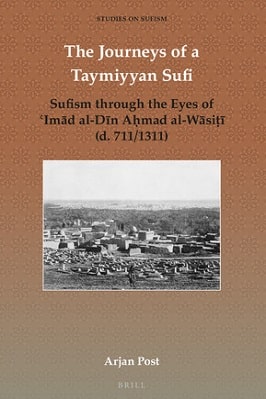
| Book Title | The Journeys Of A Taymiyyan Sufi |
| Book Author | Arjan Post |
| Total Pages | 337 |
| Book Views | |
| Language | English |
| Book Download | PDF Direct Download Link |
| Get Hardcover | Click for Hard Similar Copy from Amazon |
The Journeys of a Taymiyyan Sufi – Sufism through the Eyes of ʿImād al-Dīn Aḥmad al-Wāsiṭī (d. 711/1311) By Arjan Post
THE JOURNEYS OF A TAYMIYYAN SUFI
Book’s Introduction
In the summer of 2014, I visited the Universitätsbibliothek Basel to view the Nachlass of Fritz Meier, a collection of personal unpublished papers and notes the late Swiss scholar of Sufism bequeathed to the university.
At that time, I still aspired to devote my PhD project to the much-debated Ḥanbalī shaykh al-Islām Taqī al-Dīn Aḥmad ibn Taymiyya (d. 728/1328) and his supposedly fraught relationship with taṣawwuf, commonly known in the West as Sufism.
I was aware that Meier’s Nachlass contains some material that deals with this very topic and was hence curious to see what I would find. As I went through the many pages of the Nachlass, I came across a note concerning ʿImād al-Dīn Abū al-ʿAbbās Aḥmad al-Wāsiṭī, who was known to me as a companion of Ibn Taymiyya.
I had found out long before that al-Wāsiṭī was in fact recognized by his contemporaries as a ṣūfī, a notion that intrigued me given his membership of Ibn Taymiyya’s circle. In that regard, Meier made an observation that caught my attention. Referring to al-Wāsiṭī as ‘al-Ḥizāmī,’ he wrote:
This is a case of the connection between Sufism and orthodox Ḥanbalism, at the same time a convergence of the Šādiliyya and Ibn Taymiyya. In the person of Ibn Taymiyya and in the person of Ibn ʿAṭāʾ Allāh al-Sikandarī the two positions clash with each other.
They merge in Ḥizāmī. Šādilism is a return to classical Sufism, or at least a recollection thereof, [it is a form of] classicism.
Ibn Taymiyya represents a reform of Sunna, an attempt to brush off the contaminated traditionalism and reconnect with the ancient foundations of orthodoxy. Both of these seem to have converged here in Ḥizāmī. Ḥizāmī sought to link the acceptable and good of Šādilī mysticism with the oldest form of Islam.
Ḥizāmī recognized Ibn Taymiyya as a great reformer and leader and was on his part recognized by Ibn Taymiyya as a great Sufi. It is appealing that Ḥizāmī did not abandon Sufism, but simply put it on a Ḥanbalī basis.
By coincidence, just a few months earlier in March, I discovered that a large number of al-Wāsiṭī’s works had quite recently been edited and published.
Since Meier did not disclose the source on which he based the above-quoted observation, I was curious as to whether I could find proof for it in al-Wāsiṭī’s own books.
Meier thus gave me the final nudge I needed to start reading the material that was to become the main source for the research I would conduct for the next three years – though at that point I still simply wanted to see whether al-Wāsiṭī would be of any use to our understanding of Ibn Taymiyya’s relationship with Sufism.
As I skimmed through several of the titles at my disposal, I was fascinated by the richness of al-Wāsiṭī’s thought on Sufism and realized that we have here a scholar who deserves to be studied in his own right. And this is exactly what the present book sets out to do.
But before I turn to discuss the relevance of studying al-Wāsiṭī and the approach of this volume, some preliminary remarks must be made concerning Sufism, traditionalism, and Ibn Taymiyya, for it is within the scholarly discussions on these topics that we must attempt to situate al-Wāsiṭī.
A Contextual Approach to Studying Sufism(s)
What is taṣawwuf? In truth, it is hard to come up with an umbrella definition that includes its many differing, and sometimes seemingly contradictory, manifestations. Taṣawwuf is far from monolithic.
While for long the tendency has been to view it as Islam’s ‘mysticism’ and the ṣūfiyya as its ‘mystics,’ this basically leaves us with an equally thorny problem: What is mysticism? Who are mystics?
The common use among scholars of the latter terms seems to be inherited from our Orientalist predecessors, who had the anachronistic tendency to understand Islam through the lens of Christianity.
Apart from the Western-centrism implicitly present when using the terms mysticism and mystic, there is also the problem that they are difficult to define in a way that includes all groups and individuals historically associated with the terms taṣawwuf and ṣūfī.
Sara Sviri has looked at the formative period of taṣawwuf and observed that, according to her definition of mysticism and mystic, some figures she identifies as mystics were not called ṣūfīs, and some figures who were called ṣūfīs cannot be identified as mystics.2
For such reasons, there have been several scholars who have rightly problematized the use of mysticism and mystic.3 A recent critique comes from Nathan Hofer, who has opted to simply use the modern terms ‘Sufism’ and ‘Sufi’ instead, because they “bear
To read more about the The Journeys Of A Taymiyyan Sufi book Click the download button below to get it for free
Report broken link
Support this Website
Click here to join our Telegram group for new Books